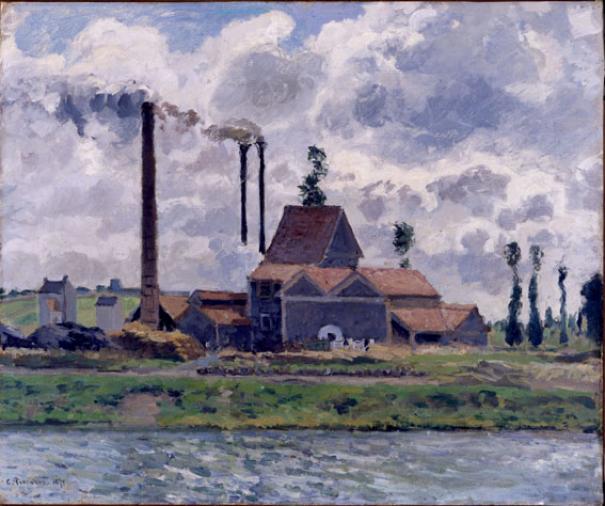About the Artist
Camille Pissarro
Born: Charlotte Amalie, St Thomas, 10 July 1830
Died: Paris, 13 November 1903
Nationality: French

Camille Pissarro, 1873
Factory Near Pontoise
Collection
Museum of Fine Arts, Springfield, MA
Documentation
In writing about Pissaro’s landscapes of the 1870s such as Factory Near Pontoise Rachael DeLue asserts :
“By attending to construction, to solidity and weight, in the space of paintings of landscape imagined to be and described as partial, mere fragments, Pissarro reinvented the relation between painting and beholder and painted pictures that called for a specific kind of viewing, pictures that, in their partialness, worked to put vision into doubt. In making of the partial something ‘absolutely seated,’ I want to claim, Pissarro produced a relation between painting and beholder, body and vision, wherein the viewer, as he looked, at times with difficulty, was made aware of his own body and, consequently, the body of the artist. As Pissarro constructed his coins [corners], into them, in the act of painting, he inscribed his own body and asked the beholder to acknowledge, fell as it were, its presence. Pissarro’s coins work to image the inmixing of the artist’s body and the world, and they seem, in all their partialness, to have been brought into being by, in [Emile] Zola’s* words, a ‘will fierce and strong,’ by an artist interested in making his presence eminently felt, by an artist interested in seating himself in his pictures of landscape.”
“The viewer encounters Pissarro in his pictures not because the artist implies that his body is actually, corporeally, in them but because he, the viewer, follows Pissarro’s visual traversal, his visual touching, in the artist’s laying on and working over of paint. We feel what the artist sees, touch by touch, stroke by stroke, in pictures so narrow as to allow only this kind of presence, a kind that can occupy, press itself into, a mere slice of…nature. Pissarro’s body locates itself in the optical effects of decoration, harmonious color, and nimble facture…”
*Emile Zola (1840-1902) was an influential French writer, leader of the Naturalism school of literature. His 20-volume Rougon-Macquart series (Nana, Germinal) describes French society during the reign of Napoleon III. He championed secularism, liberalism, and justice. Zola was an early and outspoken defender of falsely accused and convicted Jewish army officer Alfred Dreyfus.
DeLue, Rachael Ziady. “Pissarro, Landscape, Vision, and Tradition,” The Art Bulletin, vol. 80, no. 4 (December 1998): 723, 731.
Similar Subjects by Other Artists
Alfred Sisley, The Seine at Billancourt, 1879 (Kunsthalle, Hamburg)